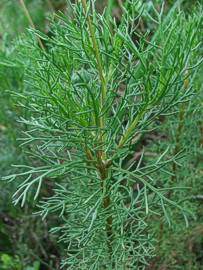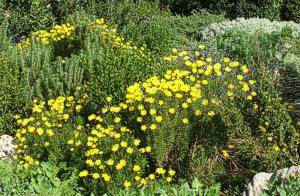Euryops abrotanifolius
Euryops abrotanifolius (L.) DC.
Family: Asteraceae
Common names: lace-leaf euryops, mountain resin bush (Eng.); bergharpuisbos, geelmagriet (Afr.)
Introduction
Euryops abrotanifolius is an easy-to-grow fynbos shrub with bright yellow daisies during winter and spring that will cheer up the winter garden.

Description
Description
Euryops abrotanifolius is an upright, densely leafy shrub, 0.2-2 m high. It is smooth and hairless except for a small tuft of woolly hairs at the base of the peduncle (flower stalk). The branches are slender and leafy in the upper parts, becoming bare lower down. The leaves are closely set, 60-90 mm long, finely divided into needle-like to thread-like lobes and a deep shade of green.

A single, large, bright yellow daisy is produced on a long, straight stalk. They are borne in profusion, making quite a show at their peak during winter and spring (June - October), and flowers can still be found in midsummer (December). The fruit is a hairless achene, 2.5-5.5 x 2 mm, with 10 distinct narrow veins and a distinct white, cylindrical appendage at the tip, 1 mm long.
Conservation Status
Status
Euryops abrotanifolius is not threatened.
Distribution and habitat
Distribution description
Euryops abrotanifolius occurs on sandy or stony mountain slopes and hillsides, usually sandstone, from sea level up to ± 1800m, in the southwestern and southern Cape from the northern Cedarberg to the Langeberg Mountains, including the Cape Peninsula where it is quite common. It is variable within its range, especially the shape and size of the leaves and length of the peduncle, e.g. in the Caledon area the plants tend to have leaves with shorter lobes and occasionally the underside of the petals of the ray florets is red.
This variation has caused quite a bit of taxonomic confusion as different authors have recognized some of the variants as distinct species. Nordenstam's revision treats them as extreme forms of the same species and those names have been put into synonymy. Furthermore, plants can look quite different depending on where they are growing, i.e. those in a sunny, exposed position have shorter, thicker leaves compared to plants growing in a more protected, shady spot, which have thinner, longer leaves.
Derivation of name and historical aspects
History
Euryops is derived from the Greek, eurys, meaning large or wide, and ops, meaning eye or face, referring to the large, showy flower heads; abrotanifolius means having leaves resembling Artemisia abrotanum, southernwood, from abrotanum, the old Latin name for southernwood, and folius meaning leaf.
The name harpuisbos means resin bush and is applied generally to Euryops species. It is a direct translation from the Dutch name harpuis bosch from the Dutch word hars (resin) and puisje (a small pimple), referring to the resinous secretion exuding from the stem and branches in the form of small pimply drops.
The genus Euryops consists of 97 species, mainly in Africa with one species extending into the Arabian Peninsula and Socotra. There are 89 species in southern Africa where they are widespread and about 30 of them that also occur in the fynbos. Many Euryops make very decorative garden subjects and the following are also grown at Kirstenbosch: E. chrysanthemoides, E. pectinatus, E. virgineus, E. tysonii, E. annae, E. linearis and E. speciosissimus.
Euryops abrotanifolius and E. pectinatus were both collected very early on, before 1753, and cultivated in European gardens.
Ecology
Ecology
Euryops abrotanifolius is quick to re-establish after a fire, becoming dominant for a few years after a burn and then slowly being replaced by other fynbos plants as the veld recovers. It is also an effective pioneer and is quick to exploit disturbed or open ground. It produces a lot of seed and germinates and grows rapidly from seed. It is not a resprouter in the sense that it does not have a lignotuber, and the plants are most likely killed by a fire, but it does readily send out new growth from older wood when branches are pruned or broken.
The appendage on the tip of the seed is the remains of a stylophore, which develops between the style base and the ovary, and functions as a nectary. It persists only in this species and E. lasiocladus, and possibly acts as an elaiosome. If it does function as an elaiosome, then the seed of these species would be dispersed by ants. i.e. the ants are attracted by the elaiosome-like stylophore, they carry the seeds away to their nests to consume it, dispersing the seeds and keeping them safe in the process.

The flowers are visited by insects in search of pollen and nectar. I observed bees and various beetles visiting the flowers on plants growing on the mountains above Kalk Bay and at Kirstenbosch, as well as a wasp-like hover fly at Kirstenbosch. These hover flies feed on pollen and nectar, and mimic wasps to protect themselves from predators although they themselves cannot sting (other species of hover fly mimic bees). They are often mistaken for wasps, but can be told apart as they have only one pair of wings. They are a good friend to gardeners as their slug-like larvae feed on aphids. The female lays her eggs among the aphids on an infested plant, and when the larvae emerge, they creep over the leaf, spear the aphids and suck their juices.
Uses
Use
The name harpuisbos or resin bush is applied to Euryops species because resin is secreted from the stem and branches of practically all of the species, although some produce more than others. It sometimes appears as blobs on the stems and twigs and collects under the bushes. In the past, this resin was greatly esteemed, by both the Khoisan and the colonists, for its alleged medicinal properties. It was used as a substitute gum, and to preserve the leather of boots and saddles.
Euryops abrotanifolius shows much horticultural potential, as a quick-growing herbaceous shrub.

Growing Euryops abrotanifolius
Grow
Euryops abrotanifolius is an easy and undemanding plant in the garden. It does best in well-drained, sandy soil in a sunny position, with regular applications of well-rotted compost. It tolerates heavy pruning and older, straggly plants can be rejuvenated by being cut back. It probably will not tolerate extreme cold, but should survive in Zone 9 (-7 to -1 C) but is best protected from frost. Outside of its native winter rainfall area, it will need to be watered during autumn-winter-spring.
Euryops abrotanifolius is ideal for the fynbos garden, and a water-wise garden in the winter rainfall area. It is also a decorative subject for a mixed border with a lower-growing plant in front to hide its bare, leafless base. It also makes a decorative pot plant when young and pruned back regularly to keep it neat and leafy.
Euryops abrotanifolius can be propagated by seed and cuttings. Sow seeds in autumn, or in spring to summer, in a well-drained medium. Stem cuttings are best taken in spring and summer, treated with a rooting hormone and placed in a mist unit with bottom heat.
References
- Goldblatt, P. & Manning, J. 2000. Cape plants. A conspectus of the Cape flora of South Africa. Strelitzia 9. National Botanical Institute, Pretoria & Missouri Botanical Garden Press, Missouri.
- Leistner, O.A. (ed.). 2000. Seed plants of southern Africa : families and genera. Strelitzia 10. National Botanical Institute, Pretoria.
- Manning, J. 2007. Field guide to fynbos. Struik, Cape Town.
- Nordenstam, B. 1968. Genus Euryops. Part 1. Opera Botanica 20, edn 1.
- Skaife, S.H. 1987. African insect life. Struik, Cape Town.
- Smith, C.A. 1966. Common names of South African plants. Memoirs of the Botanical Survey of South Africa No. 35.
- Website: The garden safari. www.gardensafari.net/english/hoverflies.htm.
Credits
Alice Notten
Kirstenbosch National Botanical Garden
July 2008
Plant Attributes:
Plant Type: Perennial, Shrub
SA Distribution: Western Cape
Soil type: Sandy, Loam
Flowering season: Spring, Early Summer, Winter
PH: Acid, Neutral
Flower colour: Yellow
Aspect: Full Sun
Gardening skill: Easy
Special Features:
Horticultural zones











Rate this article
Article well written and informative
Rate this plant
Is this an interesting plant?
Login to add your Comment
Back to topNot registered yet? Click here to register.